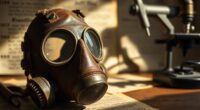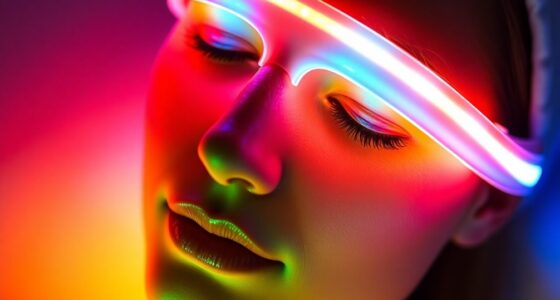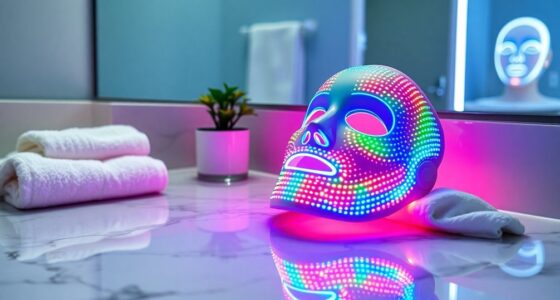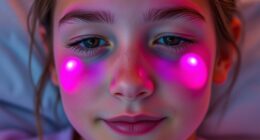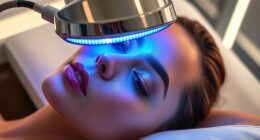LED masks use innovative light therapy to enhance your skin’s health and appearance. By emitting specific wavelengths of light, they can boost collagen production, reduce fine lines, and target acne-causing bacteria. Regular use can lead to improved texture, clarity, and hydration. Just 5-20 minutes a day can help with inflammation and repair. If you want to discover more about the types of light and their specific benefits, keep exploring this topic.
Key Takeaways
- LED masks utilize light therapy to enhance skin rejuvenation, improving texture and clarity with consistent use.
- Red light therapy boosts collagen production, reducing wrinkles and fine lines while minimizing inflammation.
- Blue light therapy effectively targets and eliminates acne-causing bacteria, reducing breakouts and redness.
- Near-infrared light penetrates deeply, promoting healing and enhancing skin elasticity.
- Regular use of LED masks can lead to cumulative benefits, with visible improvements often observed within a month.
What Are LED Masks?

If you’re looking for an innovative way to enhance your skincare routine, LED masks might be just what you need.
These LED Face Masks are designed with silicone and embedded light-emitting diodes (LEDs) that emit specific wavelengths of light, targeting various skin concerns. For instance, red light therapy (630-660 nanometers) stimulates collagen and elastin production, helping to reduce wrinkles and promote skin rejuvenation.
On the other hand, blue light (405-420 nanometers) effectively eliminates acne-causing bacteria. Comfortable and convenient, these masks feature eye and mouth holes, allowing you to multitask during your treatment.
With consistent use for just 5-20 minutes daily, you can enjoy cumulative improvements in skin texture and clarity over time.
How LED Masks Work

LED masks harness the power of specific wavelengths of light to promote skin health and rejuvenation.
These masks use light-emitting diodes (LEDs) to emit targeted light that penetrates your skin, stimulating cellular activity and enhancing collagen production.
Here’s how they work:
- Red light (630-660 nm) boosts collagen synthesis, reducing wrinkles.
- Near-infrared light (800-1,400 nm) reaches deeper layers, improving skin elasticity and aiding tissue healing.
- Regular use (5-20 minutes daily) leads to cumulative benefits like better skin texture and reduced inflammation.
- Clinical studies support their effectiveness, showing subtle improvements in skin conditions with consistent use.
Types of Light Used in LED Masks
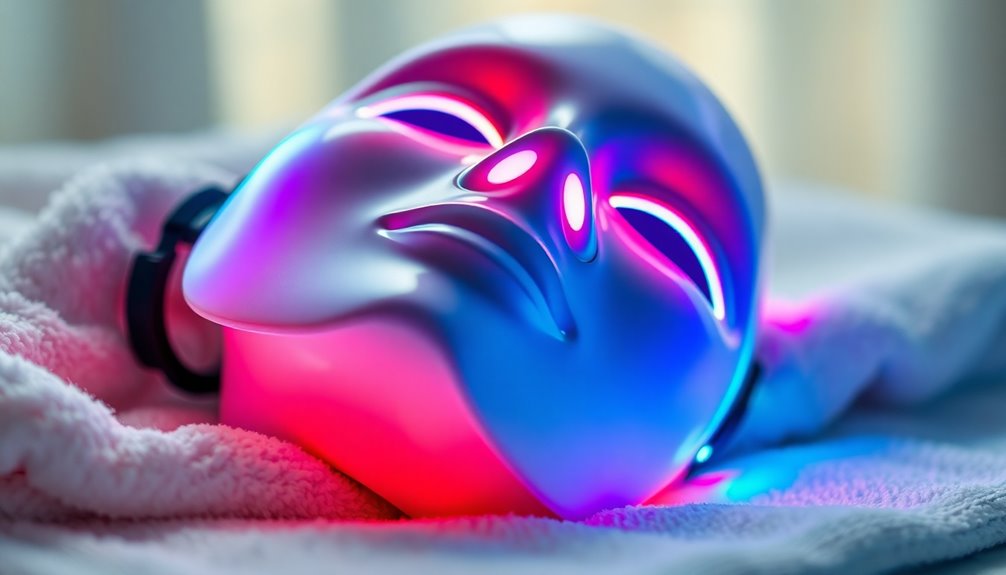
Various types of light are employed in LED masks, each offering unique benefits for your skin.
Red light therapy, with wavelengths from 630 to 660 nanometers, enhances collagen production and helps reduce wrinkles.
If you’re struggling with acne, blue light therapy operates at 405 to 420 nanometers, targeting acne-causing bacteria to control breakouts effectively.
Near-infrared light, ranging from 800 to 1,400 nanometers, penetrates deeply, promoting healing and improving overall skin texture.
Additionally, yellow light stimulates red blood cell production and circulation, while green light works to reduce pigmentation and brighten your complexion.
Benefits of Red Light Therapy

Red light therapy offers remarkable benefits for your skin, making it a popular choice in skincare routines.
This innovative approach targets various skin concerns effectively, leading to noticeable improvements.
Here’s what you can expect:
- Boosts collagen production, enhancing skin strength and elasticity
- Minimizes fine lines, giving you a more youthful appearance
- Reduces inflammation, promoting faster healing of skin conditions
- Supports overall skin rejuvenation, improving texture and tone over time
With regular use, red light therapy can transform your skin, helping you achieve a radiant complexion.
Supported by research, including insights from Dr. Akshay Sanan, it’s clear this therapy is a powerful ally in your quest for healthier, more vibrant skin.
Benefits of Blue Light Therapy

Blue light therapy directly targets acne-causing bacteria, helping you reduce breakouts and achieve clearer skin.
Its anti-inflammatory properties can soothe irritation and lessen redness from acne lesions.
Acne-Causing Bacteria Targeting
When it comes to tackling acne, blue light therapy stands out as an effective solution that specifically targets acne-causing bacteria on your skin.
This non-invasive treatment operates in the 405 to 420 nanometer range, directly killing Propionibacterium acnes, which helps reduce breakouts. Regular use can considerably improve your skin texture and clarity.
Here are some benefits of blue light therapy for acne:
- Kills acne-causing bacteria effectively
- Reduces the severity and number of breakouts
- Minimizes existing lesions and redness
- Safe for various skin types with minimal side effects
Anti-Inflammatory Properties
While many treatments for skin issues can lead to irritation, blue light therapy stands out for its remarkable anti-inflammatory properties.
This innovative approach helps reduce redness and swelling, making it especially beneficial for those with inflammatory skin conditions like acne and rosacea.
By targeting and killing acne-causing bacteria, blue light therapy not only diminishes active breakouts but also prevents future occurrences.
Its wavelength, typically between 405 and 420 nanometers, penetrates the skin to affect oil glands responsible for acne production.
Regular use can lead to a noticeable reduction in acne lesions and overall skin clarity.
Unlike some topical treatments that can irritate, blue light therapy is generally well-tolerated, offering a safe option for improving skin health.
Effects on Skin Conditions
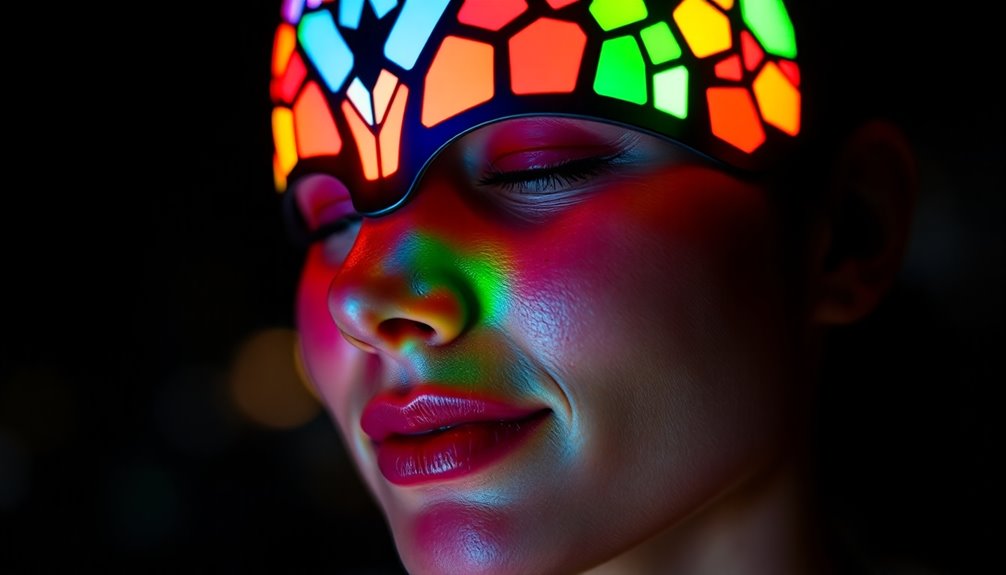
When you use LED masks, you can see significant improvements in both acne and aging skin.
The blue light effectively targets acne-causing bacteria, helping to clear breakouts, while the red light boosts collagen production to reduce wrinkles.
With regular use, you might notice smoother skin texture and a more youthful glow.
Acne Treatment Efficacy
Although many treatments exist for acne, LED masks have emerged as a popular option due to their effectiveness in combating breakouts.
Utilizing blue light therapy, these masks target the Propionibacterium acnes bacteria responsible for acne, helping to reduce active breakouts and prevent future ones.
Here’s what you can expect from LED masks:
- Effective reduction of acne lesions
- Improved overall skin texture
- Noticeable results after consistent use
- Non-invasive treatment for mild to moderate acne
Anti-Aging Benefits
After addressing acne treatment, it’s time to explore how LED masks can also provide significant anti-aging benefits. Using LED light, especially red light therapy, stimulates collagen production and improves skin elasticity, helping reduce fine lines and wrinkles. Regular use enhances blood circulation, delivering essential nutrients and oxygen to your skin cells, contributing to a youthful glow. Additionally, emotional support during skincare routines can enhance overall well-being, reflecting positively on skin appearance.
| Benefit | Description | Result |
|---|---|---|
| Collagen Production | Boosts skin firmness | Reduces fine lines |
| Skin Elasticity | Improves skin’s flexibility | Fights sagging |
| Red Light Therapy | Promotes cellular regeneration | Enhances overall texture |
| Inflammation Reduction | Minimizes redness and puffiness | Promotes a radiant look |
Incorporating LED masks into your routine can lead to a more vibrant complexion over time.
Recommended Usage and Frequency

To achieve the best results with LED masks, it’s essential to stick to a regular routine. For ideal usage, aim for five sessions a week, with each lasting between 3 to 20 minutes, depending on your device.
Consistency is key—commit to at least one month to see real improvements in your skin’s texture and tone.
Remember to:
- Wash and dry your face before treatment for better light penetration.
- Apply hydrating skincare products post-treatment to enhance results.
- Avoid using retinoids alongside the mask to reduce irritation.
- Track your progress to notice visible changes over time.
Safety and Potential Risks
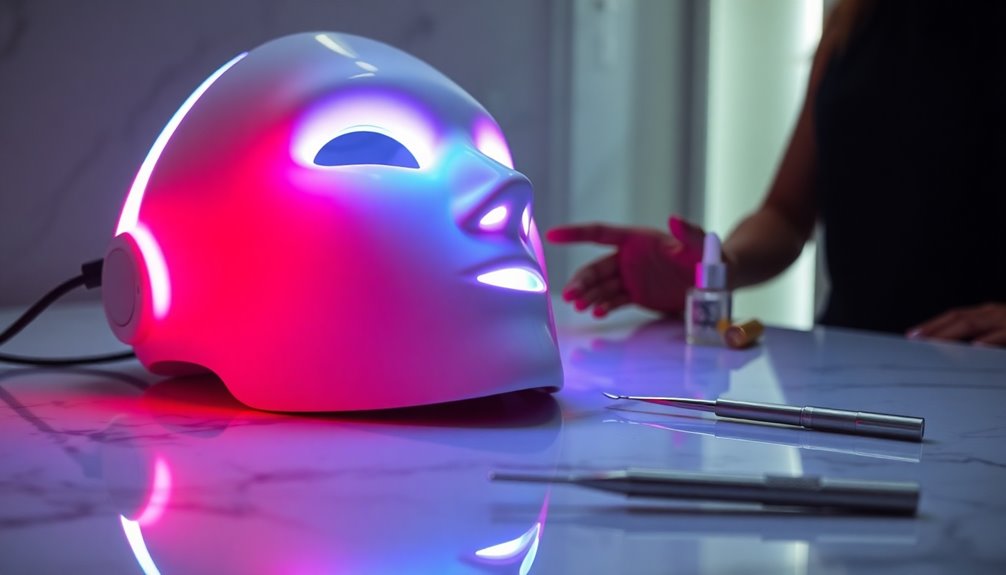
While LED masks are generally safe for most users, it’s important to be aware of potential risks, especially if you have light sensitivity. Eye protection is significant during treatments, particularly with blue light, to prevent eye damage. Overuse can lead to side effects like irritation, redness, or increased inflammation. As a result, always follow the manufacturer’s guidelines. If you have pre-existing skin conditions, consult a dermatologist before starting LED mask treatments. Long-term safety data is still limited, so monitoring your skin reactions during use is essential.
| Potential Risks | Recommendations |
|---|---|
| Light Sensitivity | Use caution and eye protection |
| Irritation | Follow usage guidelines |
| Skin Reactions | Monitor changes closely |
| Pre-existing Conditions | Consult a dermatologist |
User Experience and Testimonials
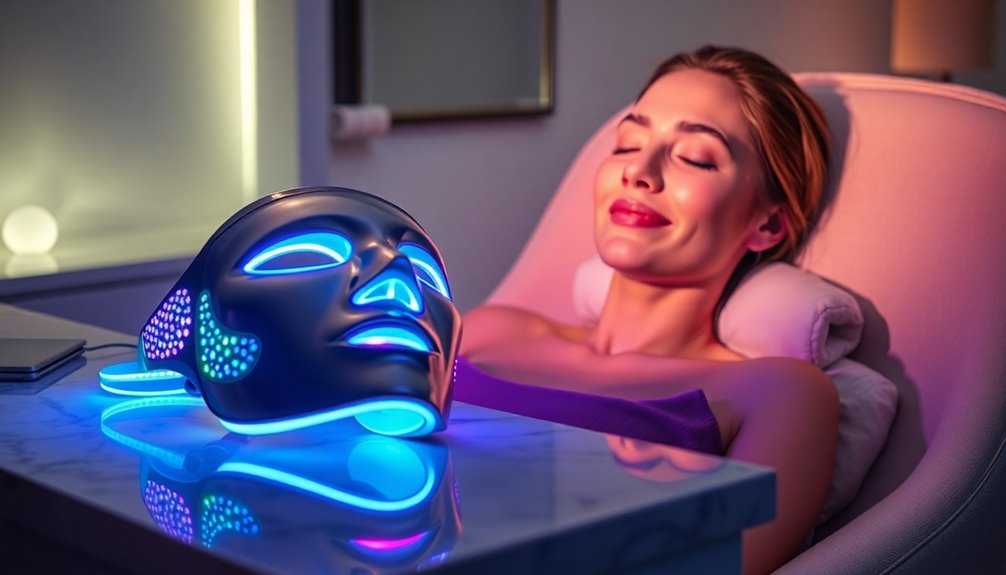
What do users really think about LED masks? Many share positive user experiences, noting visible changes in their skin after consistent use. Users often report improvements in skin texture and hydration, with some seeing results within a month.
Here’s what they love:
- Convenience: You can multitask during treatments, like watching TV or reading.
- Comfort: The adjustable fit enhances user satisfaction.
- Effectiveness: Many notice a reduction in acne and scarring, with quicker healing for breakouts.
- Progress tracking: Users recommend taking photos to assess improvements over time.
Comparing At-Home and Professional LED Treatments
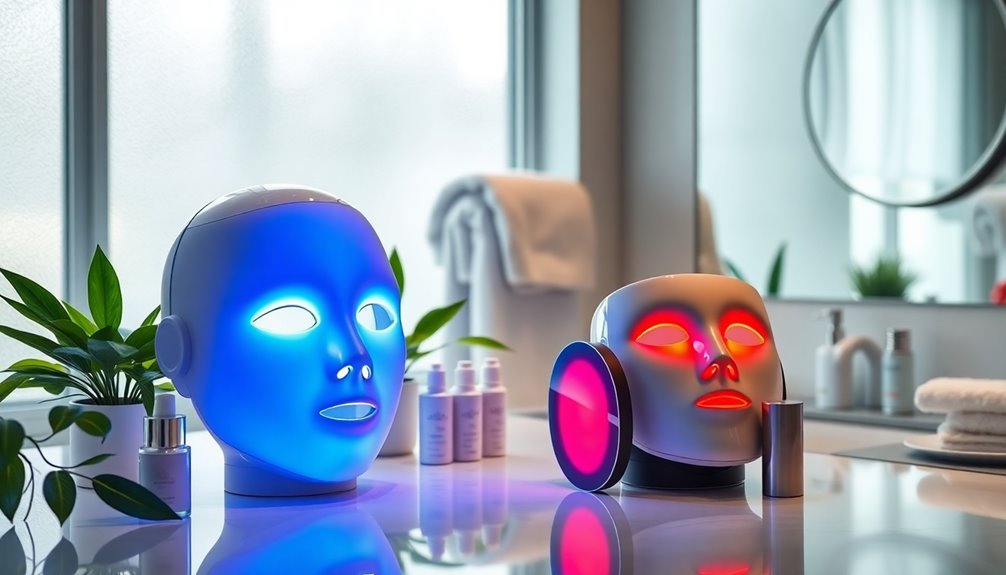
When considering LED treatments for your skin, it’s essential to understand the differences between at-home masks and professional sessions. At-home LED masks deliver lower intensity, leading to slower results, while professional treatments utilize higher-powered devices for immediate improvements. Regular at-home use can still provide cumulative benefits, typically requiring 5-20 minutes daily.
| Aspect | At-Home LED Masks | Professional Treatments |
|---|---|---|
| Intensity | Lower | Higher |
| Results | Slower, gradual | Immediate |
| Customization | Generalized | Personalized by experts |
The effectiveness of both options relies on device quality, consistency, and individual skin types. Choose based on your goals and preferences to achieve ideal results.
Frequently Asked Questions
Do the LED Masks Really Work for Skin?
Do LED masks really work for skin? Yes, they can be effective, especially when used consistently.
You’ll notice subtle improvements in texture and a reduction in wrinkles over time. Red light boosts collagen production, enhancing elasticity, while blue light targets acne-causing bacteria.
While at-home options may not be as powerful as professional treatments, they still offer a non-invasive way to improve your skin health.
Just be mindful of potential irritation from excessive use.
What Are the Disadvantages of a LED Mask?
When you consider using an LED mask, there are some disadvantages to keep in mind.
Overuse can lead to skin irritation or redness, especially if you have sensitive skin. You might find that at-home devices aren’t as effective as professional treatments, resulting in limited results.
Additionally, long-term safety data is scarce, and varying results can occur based on your skin type and the device’s quality.
Don’t forget eye protection, especially with blue light!
How Often Should I Use a LED Mask?
Did you know that consistent use of LED masks can lead to noticeable skin improvements in as little as a month?
To get the best results, you should use your LED mask about five times a week for 10 to 20 minutes each session. This frequency allows your skin to reap the cumulative benefits over time.
Remember to give your skin at least 24 hours between sessions to avoid irritation, especially if you’ve got sensitive skin.
How Long Does It Take to See Results From a LED Face Mask?
You’ll likely start noticing subtle improvements in your skin texture and tone after using an LED face mask consistently for about 4 to 6 weeks.
While some might see immediate effects, like a glowing complexion, more noticeable changes, such as reduced fine lines and better hydration, usually require regular sessions of 5 to 20 minutes, 3 to 5 times a week.
Conclusion
In the world of skincare, you’ve probably heard the saying, “An ounce of prevention is worth a pound of cure.” LED masks offer a convenient and effective way to enhance your skin’s health and appearance from the comfort of home. With their various light therapies catering to different skin concerns, these masks can be a game changer. So, why not give it a try? Your skin deserves that extra glow, and you might just find your new favorite beauty tool.

